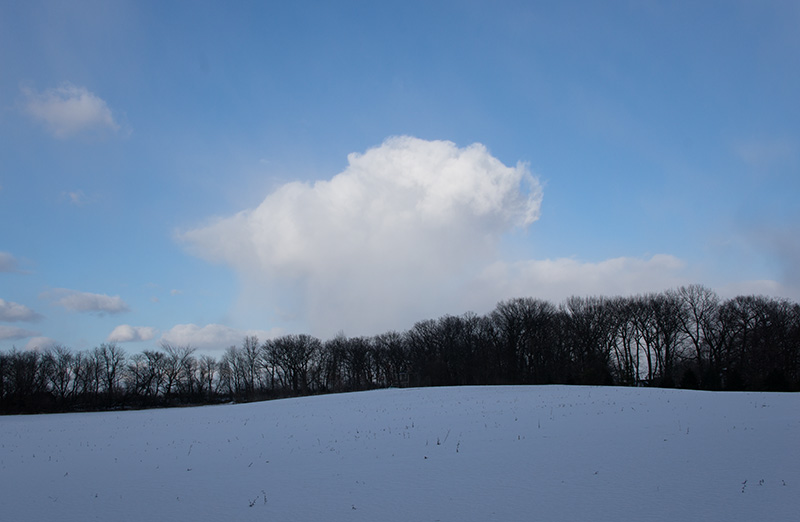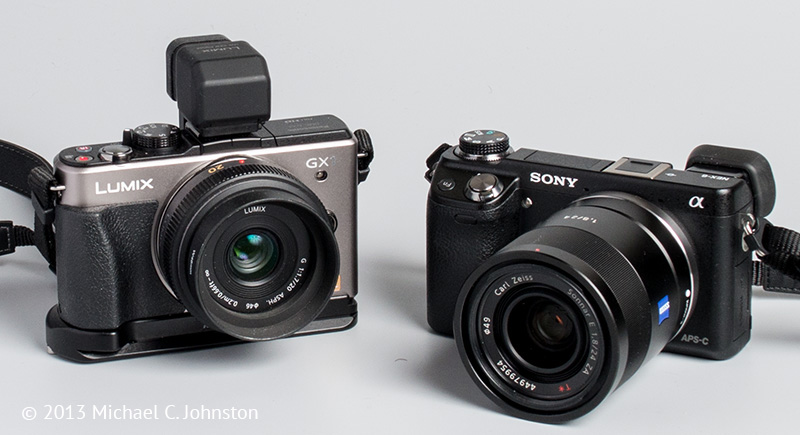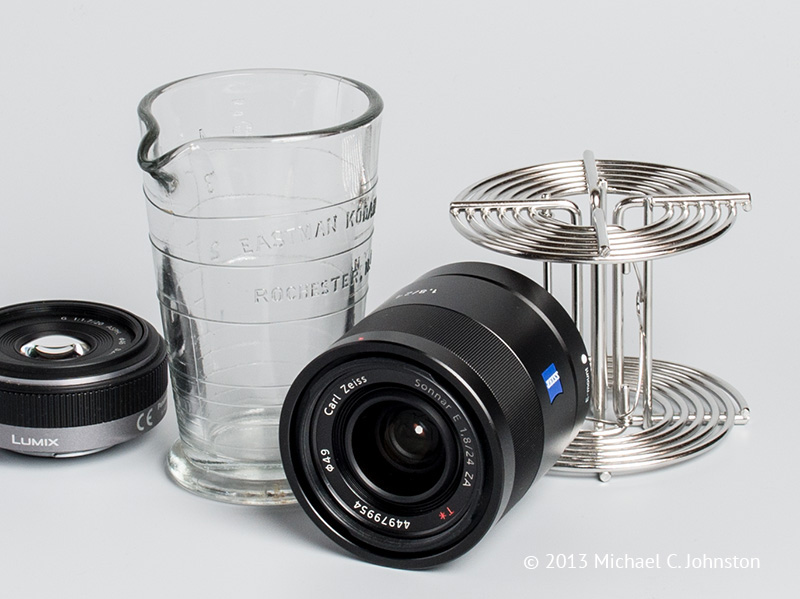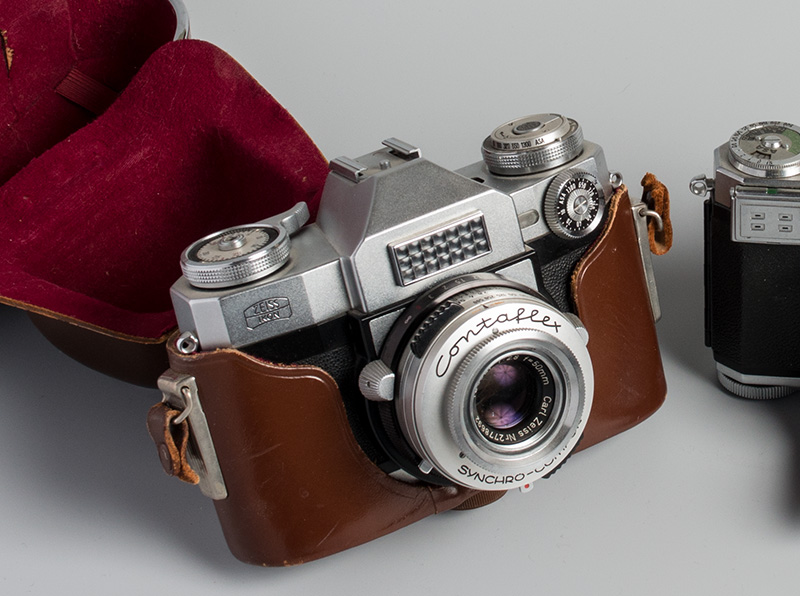Today (Wednesday, as I write) is the last day of Winter, so of course spring is about as much in evidence as Jimmy Hoffa down at Karl Ratzsch's having a second helping of Wiener Schnitzel. The mercury pegged a measly 7 on Daniel Gabriel Fahrenheit's scale this morning (that's –14°C for you enlightened ones) and warmed to a relatively balmy 17° (–8°C) by the afternoon. But it was windy. Wisconsin is doing a darned good imitation of the dead of winter. The whole world is frozen solid.
Willing to brave anything for my beloved readers, and manly to the core, I girded for warmth, assembled the newly arrived Sony NEX-6 and Zeiss 24mm ƒ/1.8 Sonnar E, and headed out into the howling cold. I laugh at frostbite when your entertainment is at stake.
Okay, I am lying.
What really happened is that I headed out in the SUV, and my bravery mainly consisted of lowering the window every now and then, making a few snaps, and then hastily putting the window up again. But hey, it was colder than a cootie's patootie out there, people. Whaddaya want from me? At least I was out there filling the little buckets with photons.
Normally the first thing I would do with a new camera is to give you my first impressions, but I think I'm going to wait a few days for that*. Above is the NEX-6 and its match-made-in-Oberkochen next to my nearly-new Panasonic GX1 which I love. (I've committed to add the words "which I love" every time I write "Panasonic GX1" as part of the effort to fend off temptation.)
Note that in the illustration, the Panasonic GX1 which I love has a Really Right Stuff tripod plate on the bottom of it.
The biggest difference between the two cameras in the picture above—besides the fairly radical difference in the relative size of their lenses, which is obvious—is that the GX1 which I love has a tilting electronic viewfinder (EVF) and a viewing screen on the back of the camera that doesn't tilt, and the Sony is the opposite.
Which is best? I'll be darned if I know. I like both, need neither, and, when it gets right down to it, don't know which I'd rather have. At the same time, I don't hanker to have both, although I might not mind.
Romance
So actually, you know what? I really love small cameras with big sensors. I do. I loved using the Ricoh GXR despite the monumental quirkiness of its concept, I sorta even kinda hafta love the OM-D even though its control system annoys me every single time, I loved the GF1 I used for three years. I even love the idea of DMD's I haven't even used yet, like the Fuji X-E1 and the Nikon Coolpix A.
I like the whole idea of them. They're just all really neat little things, and using them is as close to play as I need to get. They're just fun.
I'd probably own all of them if I could. Well, not all. Many. Six or seven, even.
I like the category so much I hardly think you can go all that wrong. Get a mirrorless, play, have fun, be happy.
And since the evolving theme of this post seems to be love, I have another lurid confession to make along those lines: I love Carl Zeiss lenses. I truly do. I always have. And still do. Yes, of course Zeiss makes (and labels) a wide variety of lenses, and not all of them are to the manor born. And yes, there is less difference between lenses now than there used to be. And lenses make somewhat less difference with digital pictures, which are more malleable. We're not so stuck with what the lenses give us as we were when the lens image got burned on to the transparency.
But—and I don't have any demonstrations of this yet, give me a day or three—Zeiss lenses just do it for me. They might not be the "sharpest" lenses in the world in terms of absolute ultimate resolution (although they ain't chopped liver in that department either), but the "Zeiss Look" has an overall integrity I really appreciate. The best Zeisses all share a common house characteristic that I can best describe with the words "microcolor" and "microcontrast." They discriminate very well between very close shades of color on a minute level, and they have very good large-structure (5 lp/mm or 10 lp/mm) contrast. They tend to even their sharpness out across the image height (i.e. the whole frame) and tend to be balanced for consistency up and down the aperture range. Add very good flare and veiling glare resistance and a warm bias, and you get an image morphology that goes far beyond simpleminded notions of sharpness.
It's very tempting to say something like "Zeiss looks at every image quality, not just sharpness." But that's over the top and kind of absurd, because of course other lensmakers look at other qualities too. But I get a bit sick of all the sharpness talk. Sharpness is like crack to photo enthusiasts. They just want more more more without limit and never mind that there are sixty other considerations that go into the integrity of a lens image. And once they're on that crack, in true addict fashion, they let everything else in their photographic lives fall by the wayside.
Not that there's anything wrong with that.
Part of the reason I love Zeiss lenses is simply personal attachment. The very first camera I got really attached to was a Zeiss Contaflex Super BC with a fixed 50mm ƒ/2.8 Tessar. The Tessar cross-section is part of TOP's new logo. (The picture shows an original Contaflex Super c. 1957, an earlier version of "my" camera. The Super BC, which got stolen, actually belonged to my father.)
Then, when I was in photo school, I used a Contax 139Q with a few Zeiss lenses. Naturally, all the lenses I coveted during those formative years were Zeiss Contax lenses.
Naturally I'm not blind about it. I've used many great lenses from many makers, and not every lens Zeiss ever put Carl's name on is a standout. But you can see the buttons they push for me: history, youthful aspirations, etc. Naturally I've used and tested and written about a broad spectrum of the marque's offerings over the years.
If you want to get a visual idea of the "Zeiss look," go to this page and poke around. It's not possible to really "see" a lens on the Web, but with that particular lens the look comes through pretty well even on the Web. Let the page load, then scroll down. Every now and then, when a picture grabs you, click on it, and look at it a little longer. Don't pixel peep; gaze upon it. Let it soak into your eyes. As you look, try to relax all your anxious "governors"—the voices of your inner gear nerd—that are telling you what you ought to be looking for and how you ought to be feeling about it. Look at the pictures holistically. Just take in an overall impression of their optical nature. Look for "quality, not qualities." Does the whole image have integrity? Coherence, cohesiveness, consistency? Does it have a good look or a bad look to you? What's your feeling about the whole picture you're seeing? Not just its isolated, compartmentalized "image qualities." You're always seeing more than you're aware that you're seeing.
(And please, not just "sharpness." Sharpness is actually well down on the list of things I look for in a lens. It's been a long time since I've used a lens that wasn't adequately sharp. And since you can modulate the impression of sharpness in software.... Get off that crack.)
I'm going to resist going on and on about this, unless it's already too late. Suffice to say that even after only a couple of hundred exposures, it's pretty clear to me that the 24mm ƒ/1.8 E-series Sonnar ZA is a true Zeiss. With everything that very loaded statement implies. At least, implies in my mind.
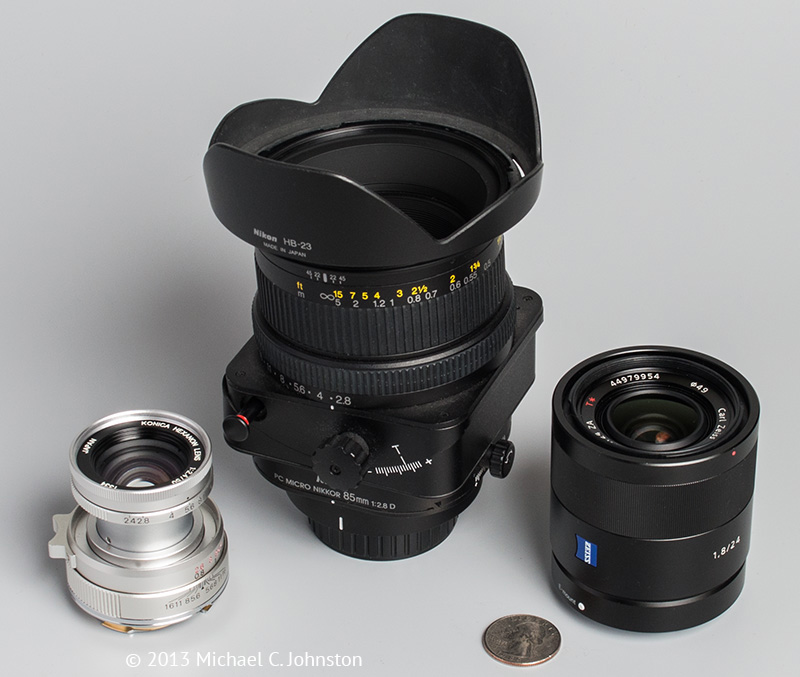 Exotic trio (for size comparison): Konica collapsible 50mm ƒ/2.4 in Leica thread mount (LTM) (this one has an M adaptor on it); Nikon PC Micro-Nikkor 85mm ƒ/2.8D; and the Zeiss 24mm E lens.
Exotic trio (for size comparison): Konica collapsible 50mm ƒ/2.4 in Leica thread mount (LTM) (this one has an M adaptor on it); Nikon PC Micro-Nikkor 85mm ƒ/2.8D; and the Zeiss 24mm E lens.
So, is it too big? Well, handling-wise, the biggest issue for me is the shutter-button placement on the NEX-6. Although the grip is generous and deep, the shutter is a bit too close-in for perfect comfort, with my man-hands. (Whoops, another Seinfeld reference.) It depends on whether you depress the shutter with the tip of your index finger or with the inside of the first knuckle on your index finger. In the latter case it's a bit more comfortable.
Both the NEX-6 as well as the Panasonic GX1 which I love are right on the verge of being too small for me. Neither crosses that line, but both of them come up right against it.
I don't think I mind the size of the lens in the least. But then, I don't carry my cameras in pockets, and...well, you can tell from the mass of verbiage above that I might be justifyin' a tad. I do notice that the camera is more awkward to carry than the Panasonic GX1 which I love, but in the hand it feels fine (the lens isn't heavy).
 Scarecrow, presently unemployed. I actually got out of the car to take this. See what I do for you? Okay, not for very long.
Scarecrow, presently unemployed. I actually got out of the car to take this. See what I do for you? Okay, not for very long.
So the big takeaway from Day 1 is I think I like this lens, with a lot of verbiage as exclamation points. Hopefully I'll be able to demonstrate why halfway adequately in the days to come. I'll give it a shot.
More soon, maybe after the weekend.
Mike
(Thanks to John Camp for the loan of the PC Micro-Nikkor)
*Which brings up an existential riddle. Will they still be first impressions?
Current products mentioned in this post:
Sony NEX-6 ($848)
Zeiss Sonnar T* E 24mm ƒ/1.8 ZA lens ($1,098)
Panasonic GX1 which I love
(a steal right now at $279)
Panasonic DMW-LVF2 accessory electronic viewfinder ($161)
Ricoh GXR (modular system)
Olympus OM-D E-M5 ($949)
Fujifilm X-E1 ($999)
Nikon Coolpix A ($1,097)
Zeiss Makro Planar T* 100mm F/2 ZE for Canon SLRs ($1,843)
Zeiss Macro Planar T* 100mm ƒ/2 ZF.2 for Nikon SLRs ($1,843)
Original contents copyright 2013 by Michael C. Johnston and/or the bylined author. All Rights Reserved. Links in this post may be to our affiliates; sales through affiliate links may benefit this site.
(To see all the comments, click on the "Comments" link below.)
Featured Comments from:
Manuel: "I'll never get to grips with those NEX-system lenses. Not just because they're big, but they look completely out of proportion on that tiny body. Like a well-endowed dwarf...."
Dennis Ng: "You should write Zeiss lens advertisements. Got a Hassey but try to resist adding Zeiss lens on my Sonys (A77 and NEX-5N). Please, no diabolic suggestion."
Drew: "The NEX-5R has the same sensor and imaging properties as the NEX-6.
Unlike the NEX-6, it has an articulated touchscreen LCD. This is
immensely practical for tripod work. Just tap on the screen where you
want to focus and proceed to giterdone. It is slicker than butter on hot
toast.
Furthermore, the accessory EVF for the NEX-5R is articulated.
These are two extremely practical benefits of the NEX-5R over the NEX-6, yet the
former camera is somehow considered more professional.
By the way, the accessory EVF for the NEX cameras is on sale for $218.49
until the end of the month at B&H."
Ken Ford: "I'm going to live vicariously through you on this one, Mike. I've come very close to buying a Zeiss 24mm ƒ/1.8 for my NEX-7 several times, but I keep chickening out with worries of Sony pulling a Minidisc on the whole NEX mount and leaving me with an exceptional $1,000 paperweight. I'll keep soldiering on with my Sigma 30mm and a few OM and Nikkor manual focus lenses instead. (The OM 24mm ƒ/2.8 and 50mm ƒ/1.8 MIJ are particularly nice on an NEX-7.) But, I’d be lying if I said that I didn't want the Zeiss...."
Adam Maas: "For those complaining about the size of the NEX lenses, be aware that the only two large primes are in fact the ZA E 24mm ƒ/1.8 and the 50mm ƒ/1.8 OSS. The 35mm ƒ/1.8 OSS for example is just about exactly the same size as the Panasonic/Leica DG Summilux 25mm ƒ/1.4 for Micro 4/3rds, the 30mm ƒ/3.5 Macro is about the same size, and the 16mm and 20mm pancakes are diminutive.
"As a practical matter, the two large primes are just about exactly the same size as a a compact 35mm lens of comparable focal length on an adapter. That is to a great extent because that is exactly what they are. The 24mm ƒ/1.8 design is very much a retrofocus design with the rear element around 2 cm from the mount; the 50mm ƒ/1.8 combines unusual close focusing (0.39m for a 50mm), OSS and a very telecentric design for the large size.
"On the zoom side, the large lenses are the 18–200mm's (big for range reasons; the original and the PZ are also optically excellent designs, which increases size) and the 10–18mm ƒ/4. The 16–50mm is tiny and the 18–55mm and 55–210mm are in the middle, large but not abnormally so.
"Much hay has been made about the size of the NEX lenses, especially in comparison to the Micro 4/3 lenses. Micro 4/3 continues to retain a size advantage due to coverage and focal length choices, particularly in the normal and wide ranges, but the real matter is that NEX bodies are diminutive with average sized lenses while Micro 4/3 offers large (GH3) through tiny (GF5) bodies so that you can better match your body to your lens selection."
Barry Reid: "An ode to Zeiss indeed, Mike, but why not...I'm a relatively recent convert after picking up a Contax / Yashica (C/Y) 50mm ƒ/1.7 for £10 in a charity shop (U.S. translation: thrift store) a few years back. Before that I was aware of Zeiss but didn't really imagine their lenses could be so addictive. Since then I've gone through buying and selling a bunch of different Zeiss lenses and am also completely smitten with the rendering of some. Particularly the 18mm Distagon, which is flawed in modern terms but has a really special character about it.
"Ironically, I sold my Zeiss glass a few weeks back to fund my NEX-6, a camera chosen in the basis that there will shortly be a useful range of 'native' Zeiss lenses to choose from.... When I can afford them! In the mean time I've just picked up a bargain 45mm ƒ/2.8 Tessar to play with and await my C/Y > NEX adapter."
